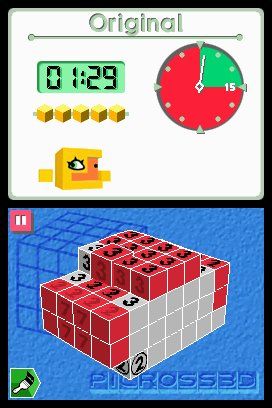12DOVE Verdict
Pros
- +
Three dimensions adds a layer of satisfaction
- +
Chunky
- +
mind-stroking fun
- +
Cute art style
Cons
- -
Light jazz soundtrack begins to grate
- -
Not ultimately better than 2D
- -
Merely functional graphics
Why you can trust 12DOVE
It takes 24 seconds to go from springing the DS power switch to smashing Picross 3D’s blocks. Instant fun. How easily writing a review becomes a ‘quick go on Picross 3D’.

Picross, for the uninitiated, is a nonogram puzzle: a grid of squares to be coloured in or left unmarked, as indicated by numeric clues. Numbers dictate clumps of marked squares along an axis; the puzzle is marking the squares so they satisfy numbers on both axes at once. Basically, it’s Minesweeper meets a crossword. Picross 3D is Michael Bay’s Picross. Not content with two axes? BAM! Have another. Marking out the wanted squares? HA! Let’s destroy the unwanted.
Grids? They’re so Picross DS. These days, we’re all about the cube. Inside that cube is a shape – could be a flip flop, could be a toucan – and only by following the numbers can you release it. This means two things: 1) brilliant boxart of a puppy being excavated from what looks like a concrete overcoat; 2) we get to chip away excess cubes, adding a smashy-smashy tactility missing from the original’s more yogic grid colouring.
As the dimensions swell, the playfield shrinks: on the tiny DS screen a 20x20 grid would struggle to spin, like a fat lady in an elevator. The numbering system is elegantly sheared away, too – a single digit describes the number of keepers, with shapes around the number dictating gaps. If (when) it gets too much, a cross-sectioning tool planes unwieldy shapes into more manageable 2D layers – just like the original Picross DS, in fact.
It’s an easier game. Getting stuck is a matter of perspective – swivelling or using cross-sections will usually uncover the untapped block. Fact is, 2D was easier to represent visually, so it was able to go to more complicated places, such as letting you pencil in potential solutions to see how they’d unfold. Picross 3D has a more brutish ‘yes’ or ‘no’ to proceedings, ‘maybe’ never factors into it. It’s still taxing under a tight time limit, but nowhere near as conceptually clever.

But while it’s certainly easier, it’s a more satisfying experience. One that lets you excavate crude 3D models of metronomes and paperclips and watch them jiggle a funny dance. One that eats the days with 350 puzzles and more to download. One that lets you smash, but smash cerebrally. One that loads in 24 seconds. Lovely.
Mar 17, 2010
More info
| Genre | Puzzle |
| Description | While it’s certainly easier than the last Picross, it’s a more satisfying experience. One that lets you excavate crude 3D models of metronomes and paperclips and watch them jiggle a funny dance. One that eats the days with 350 puzzles and more to download. One that lets you smash, but smash cerebrally. One that loads in 24 seconds. Lovely. |
| Platform | "DS" |
| US censor rating | "Everyone" |
| UK censor rating | "3+" |
| Release date | 1 January 1970 (US), 1 January 1970 (UK) |

PlayStation's cancelled reboot of its vehicular combat classic was reportedly a battle royale that let you exit the vehicles, for some reason

Steam Next Fest's biggest Soulslike is about to jump from PC to PS5 and Xbox, and everyone seems to love the demo just as much as we did

Keanu Reeves has a very blunt reaction to if he'd return for another John Wick movie: "The character's dead"
Most Popular



